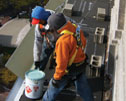For a roofing contractor trying to maintain a competitive edge, the value of an efficient, organized and safe warehouse cannot be overstated. However, similar to construction job-site requirements, regulations for the safe operation and layout of warehouse and storage areas often are enforced by numerous government entities, which can result in confusion.
To ensure a safe warehouse environment for your employees, you must be familiar with the numerous warehouse safety regulations and implement proper procedures to comply with those regulations.
Warehouse operations
Warehouse operations typically are subject to rules in 29 CFR 1910.
According to 29 CFR 1910.22, aisles and passageways must have "sufficient safe clearances" and be kept clear and in good repair. Permanent aisles must be marked—usually by high-visibility paint or tape. Local building codes and fire codes also may establish specific requirements for aisle widths, load capacities for floors, aisle markings and various other requirements.
Your insurance company also may have requirements for your warehouse regarding aisle widths, heights of material stacks, marking and warning signs, and flammable or combustible liquid storage.
Safety requirements for forklifts, or "powered industrial trucks" in OSHA terminology, are detailed in 29 CFR 1910.178 and include rules for operation, maintenance, fuel handling and storage, loading and operator training. One prominent forklift requirement is that an employer must "certify that each operator has been trained and evaluated" according to the standard's requirements.
A common misconception about forklift operator certification is it must be conducted by an outside entity that delivers some form of certified training. However, roofing contractors who train and evaluate forklift operators in-house are in full compliance with the standard as long as the training complies with the training program content set out in the regulation.
Specific forklift operational requirements according to OSHA rules include:
- A person may not stand or walk under the elevated portion of any forklift while it is loaded or empty.
- Forklifts must be equipped with overhead guards that protect the operators from falling objects.
- Forklifts may not be driven up to anyone standing in front of a fixed object.
- Loads may not be lifted that exceed a forklift's rated capacity.
Also, warehouses often contain storage areas for flammable and combustible liquids, and OSHA rules limit the quantities of such liquids based on their hazardous-nature classifications.
OSHA classifies flammable and combustible liquids according to flash point—the temperature at which a liquid gives off a vapor sufficient to form an ignitable mixture with air—and boiling point. The lower a liquid's flash and boiling points, the more volatile the liquid and generally the less that may be stored indoors. Flash and boiling points can be found on products' material safety data sheets.
OSHA also requires that employees have access to a Class B fire extinguisher within a 50-foot travel distance in areas where flammable or combustible liquids are stored.
Local fire codes also may limit quantities of such materials stored and placement of fire extinguishers.
General storage conditions according to OSHA rules require that materials be stacked, blocked, interlocked and limited in height to ensure stability against collapse.
Establish a plan
OSHA rules governing warehouse storage and operations are complex, and some reference National Fire Protection Association standards and other voluntary consensus standards with which you may not be familiar. Local regulatory agencies and insurance companies also may enforce rules or provisions that restrict how you structure and operate your warehouse.
You should establish a comprehensive plan for organizing warehouse operations and address the overlapping restrictions placed on you by various entities.
Harry Dietz is NRCA's director of risk management.



